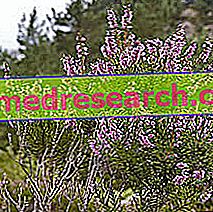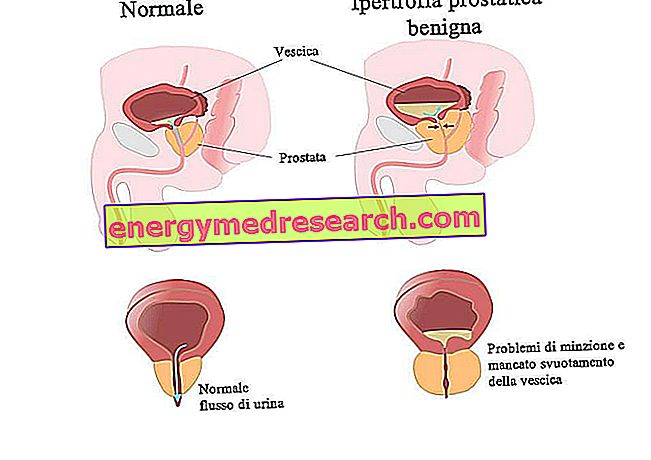
Scientific name
Allium sativum L.
Family
Liliaceae
Origin
Europe and North America.
Used Parts
Fresh bulbs.
Chemical constituents
The most important constituent of garlic is alliin, which in the bruised bulb, following enzymatic reactions (allinase), gives rise to the formation of allicin (active principle responsible for the characteristic smell of garlic), allyl disulfide, ajoene (a lipoxygenase inhibitor with platelet anti-aggregation activity), vinilditiine and terpenes.
Garlic in Herbal Medicine: Properties of Garlic
Garlic, besides being widely used in culinary, also has interesting therapeutic properties. More in detail, this plant is credited with immunostimulant, antihypertensive, antiplatelet, hypocholesterolemic and hypoglycemic agents.
For external use, the garlic exhibits antiseptic and rubefacient properties, which make it useful against boils, acne and anthrax manifestations.
Biological activity
As mentioned above, many therapeutic properties are attributed to garlic. Some of these have been widely confirmed by several clinical studies, so much so that the use of this plant has been officially approved to counter hypertension, to decrease too high cholesterol levels and to prevent arteriosclerosis.
As for the antihypertensive properties attributed to garlic, it seems that these are exerted above all by allicin and by the other polysulphides present inside the plant. The mechanism of action with which polysulphides are able to counteract hypertension has not yet been fully identified, although several hypotheses have been made on the subject. According to some studies, garlic would exert its antihypertensive action both through a mechanism of direct expansion at the level of the vasal endothelium, and by inhibiting the angiotensin-converting enzyme (or ACE).
The cholesterol-lowering action is always ascribed to the allicin present in the plant, which appears to be able to inhibit the synthesis of cholesterol through a mechanism that involves the inhibition of hydroxymethylglutaryl-CoA reductase (ie, inhibiting one of the enzymes involved, in fact, in the synthesis of cholesterol).
The preventive activity against arteriosclerosis, on the other hand, seems to be due to the set of antihypertensive and hypocholesterolemic actions performed by the same garlic, but not only. In fact, the ajoenes and the allyl disulfide contained in garlic have been shown to also possess anti-platelet aggregation properties. More in detail, ajoenes interact directly with the fibrinogen and lipoxygenase platelet receptors; while the allyl disulfide exerts an inhibitory role against the enzyme that allows the formation of thromboxane A2 (powerful platelet aggregator).
However, numerous studies have been conducted on garlic and its chemical constituents to investigate further activities. Some of the research conducted revealed new therapeutic properties of garlic that could be exploited in the medical field. Among these, its potential antioxidant activity - exerted through the increase in intracellular levels of glutathione - and the immunostimulatory activity exerted, instead, through an increase in Natural Killer cells, certainly stand out.
Other studies, however, have highlighted the potential anticancer properties of garlic. In fact, from the results obtained it emerged that garlic is able to inhibit the phases of carcinogenesis and to inhibit the growth of malignant cells.
Furthermore, according to research conducted on animals, garlic would be able to increase the release of insulin and to protect its degradation, thus exerting a hypoglycemic action.
Finally, in tests conducted in vitro, garlic - in particular the alicin it contains - has also been shown to possess antibacterial, antifungal and antiviral activities.
Garlic against hypertension
Thanks to the vasodilating action and the ability to inhibit the activity of the angiotensin-converting enzyme, possessed by the sulfur substances contained therein, garlic can be used as a remedy to counter hypertension.
From the clinical studies conducted, it emerged that a dose of 200-300 mg of garlic powder taken between two and three times a day is effective in decreasing blood pressure in patients suffering from hypertension.
Garlic against hypercholesterolemia
The use of garlic has also been officially approved for the treatment of hypercholesterolemia, thanks to the inhibition of one of the enzymes involved in the synthesis of cholesterol (hydroxymethylglutaryl-CoA reductase) operated by the alicin contained within the same plant .
Generally, to lower cholesterolemia, the recommended dose is about 600-900 mg of garlic powder per day (standardized to 1.3% in allicin).
Garlic to prevent arteriosclerosis
Thanks to the antihypertensive, hypolipidemic and antiplatelet properties possessed by allicin, ajoenes and allyl sulphide contained within garlic, this plant has proved a valid aid in preventing the onset of arteriosclerosis.
For the prevention of the aforementioned disorders, it is usually recommended to take 600-800 mg of garlic powder per day.
Garlic in folk medicine and homeopathy
Garlic has long been used also in folk medicine, where it is used internally as a remedy to counteract the inflammatory diseases of the respiratory tract, pertussis and gastrointestinal disorders mainly related to digestion and accompanied by flatulence and spasms. In addition, the plant is also used to treat menstrual pain and diabetes.
Externally, however, garlic is used by folk medicine for the treatment of otitis, neuralgia, arthritis and sciatica, as well as being used as a remedy against warts, calluses and calluses.
The uses of garlic, however, do not end there. In fact, this plant is also exploited by homeopathic medicine. Generally, it can be found in the form of granules with indications for the treatment of digestive disorders, inflammations of the upper airways and muscular pains of a rheumatic nature.
The amount of remedy to be taken may vary from individual to individual, also depending on the type of homeopathic dilution that is intended to be used.
Side effects
- Gastrointestinal level: nausea, vomiting, gastritis and diarrhea;
- Skin Level: allergic and chemical dermatitis;
- Systemic Level: allergic skin and respiratory reactions.
Contraindications
Particular attention should be paid to gastropatients, ulcers, suffering from gastroesophageal reflux disease (GERD) or esophagitis.
The use of garlic is also contraindicated during lactation and in people with certain intolerances to the plant itself or to other species of the genus Liliacee.
The use of garlic extracts on delicate skins is contraindicated, because, due to its high rubefacient power, it is not always well tolerated.
Finally, it is good to remember that given its anti-platelet aggregation activity, any garlic intake should be suspended at least ten days before undergoing surgery.
Pharmacological Interactions
- Warfarin and antiplatelet agents: increased risk of bleeding resulting from the concomitant intake of garlic, due to its fibrinolytic and antiplatelet effects;
- Vitamin E and fish oil: enhancement of antithrombotic effects;
- Pentoxifylline, ticlopidine, thrombolytics: possible increased risk of bleeding;
- Caution during concomitant use of insulin and oral anti-diabetics;
- NSAIDs: possible increase in gastrolesivity induced by these;
- Saquinavir (protease inhibitor): reduction of the bioavailability of the drug;
- Due to its anti-platelet aggregation action, it can increase the risk of postoperative hemorrhage.
Notes: most commercial products based on Garlic and its extracts do not contain a sufficient amount of active ingredients with pharmacological activity (extract enough to provide a quantity equal to 20-40 mg of allicin per day), therefore not entails risks of interference, but neither does it guarantee effectiveness.



